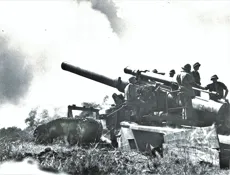 1945 - "A powerful American 240-mm (9.5-inch) howitzer projects a shell toward the Walled City of south Manila, a scene of bitter Jap resistance." (NARA) |
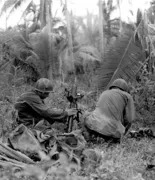 60-MM. MORTAR used to fire on enemy pillboxes. The Japanese, battling fiercely, delayed but could not stop the U.S. drive in the Ormoc valley. |
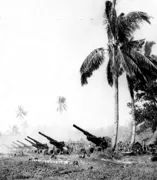 8-INCH HOWITZERS M1 EMPLACED ON LEYTE. By 5 November American forces reached the vicinity of Limon at the northern end of the valley road leading to Ormoc, the principal Japanese installation of the island. |
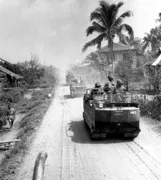 AMERICAN MOTOR CONVOY moving through the streets of a town on Leyte; vehicle in foreground is a cargo carrier M29. Valencia was taken on 18 December, Libungao on 20 December. |
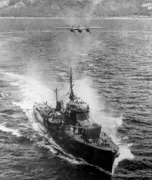 B-25 APPROACHING A JAPANESE WARSHIP in Ormoc Bay. U.S. planes, operating from fields on Morotai, raided enemy ships in Ormoc Bay on 2 November in an attempt to keep the Japanese from landing reinforcements. |
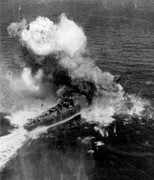 DIRECT HIT ON A JAPANESE WARSHIP by a B-25 in Ormoc Bay. Two transports and six escorting ships were sunk in the 2 November raid. |
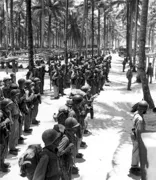 FINAL INSPECTION OF TROOPS at one of the staging areas on Los Negros, an island of the Admiralty group, before they board ships for the invasion of Leyte in the Philippines. |
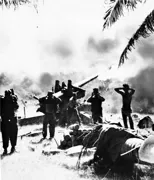 FIRING A 155-MM. GUN M1A1 on an advancing Japanese column. While U.S. ground troops advanced on Leyte, the battle for Leyte Gulf took place, 23-26 October. |
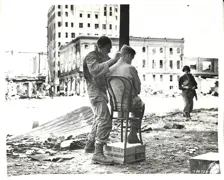 February 11, 1945 - "Everyday life goes on amid the ruins of war. Here, a GI gets a haricut from a friend in one of Manila's ruined business sections." (NARA) |
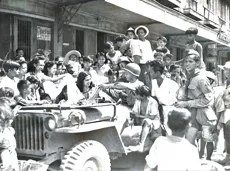 February 14, 1945 - "Joyous Filipinos greet American soldiers with Japanese silk which they had concealed during enemy occupation of Sampaloc, Manila." (NARA) |
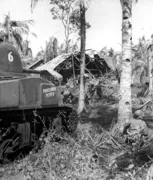 INFANTRYMEN AND A MEDIUM TANK MOVING FORWARD on Leyte. At the time of the invasion, the Japanese had only one division stationed on Leyte. |
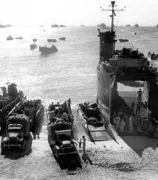 LOADING OF MEN AND SUPPLIES AT SEEADLER HARBOUR, Los Negros. The entire expedition comprised more than 650 ships of all categories. |
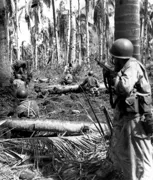 MEN CAUTIOUSLY MOVING IN on an enemy machine gun position, 24 October. The infantryman on the right is armed with a .30-caliber Browning automatic rifle M1918A2. |
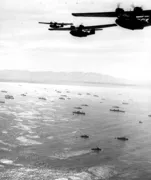 PBY CATALINA AMPHIBIAN FLYING BOATS over the U.S. invasion fleet in Lingayen Gulf, Luzon. The Luzon Campaign began on 9 January 1945 when U.S. forces landed in the Lingayen-San Fabian area. (Consolidated Vultee.) |
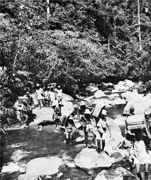 PHILIPPINE CIVILIANS carrying supplies to the front for U.S. troops. Heavy rains and deep mud harassed the supply lines and forward units were dependent on hand-carry or improvised means of transporting supplies. |
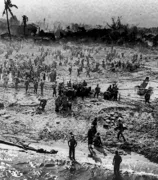 PORTION OF A LANDING BEACH ON LEYTE where Philippine civilians left their hiding places to see the American forces. Fires smoldering in the background were caused by preinvasion aerial and naval bombardment. |
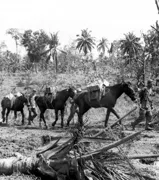 TROOPS USING JAPANESE HORSES AND MULE to transport their supplies. On 1 December seven divisions were ashore and five airfields were in operation. |
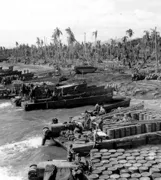 UNLOADING AT A BEACH ON LEYTE, 21 October 1944. Beyond the two barges are several LCM (3)’s. An LVT (A)(2), the armored Buffalo, can be seen on the beach. |
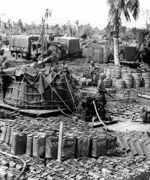 WATER SUPPLY POINT set up near a beach on Leyte, 21 October; note the collapsible water tank. By the end of the 21st, Tacloban, San Jose, Dulag, and two airfields were captured. Heavy fighting continued at Palo. |
|



















